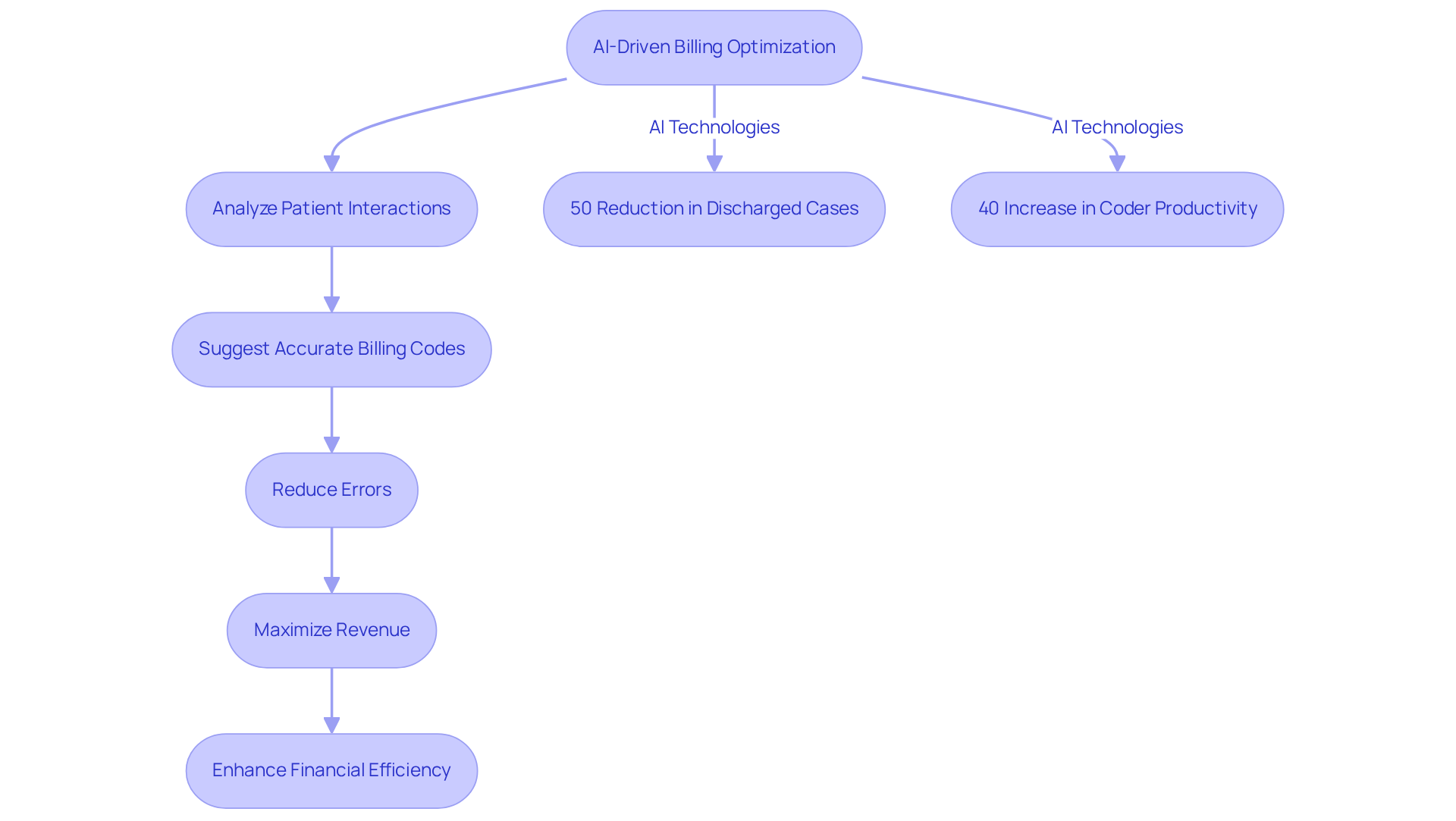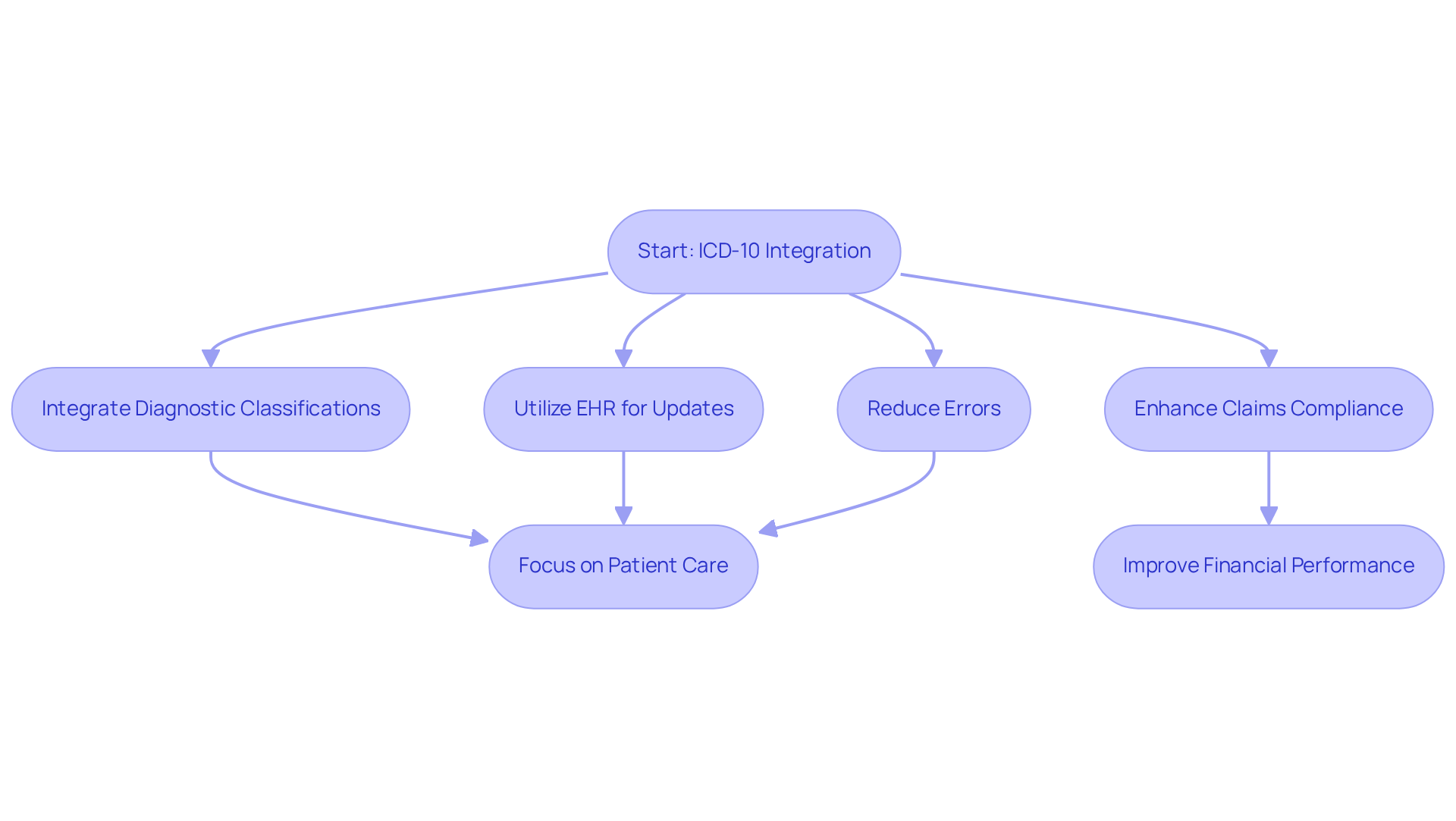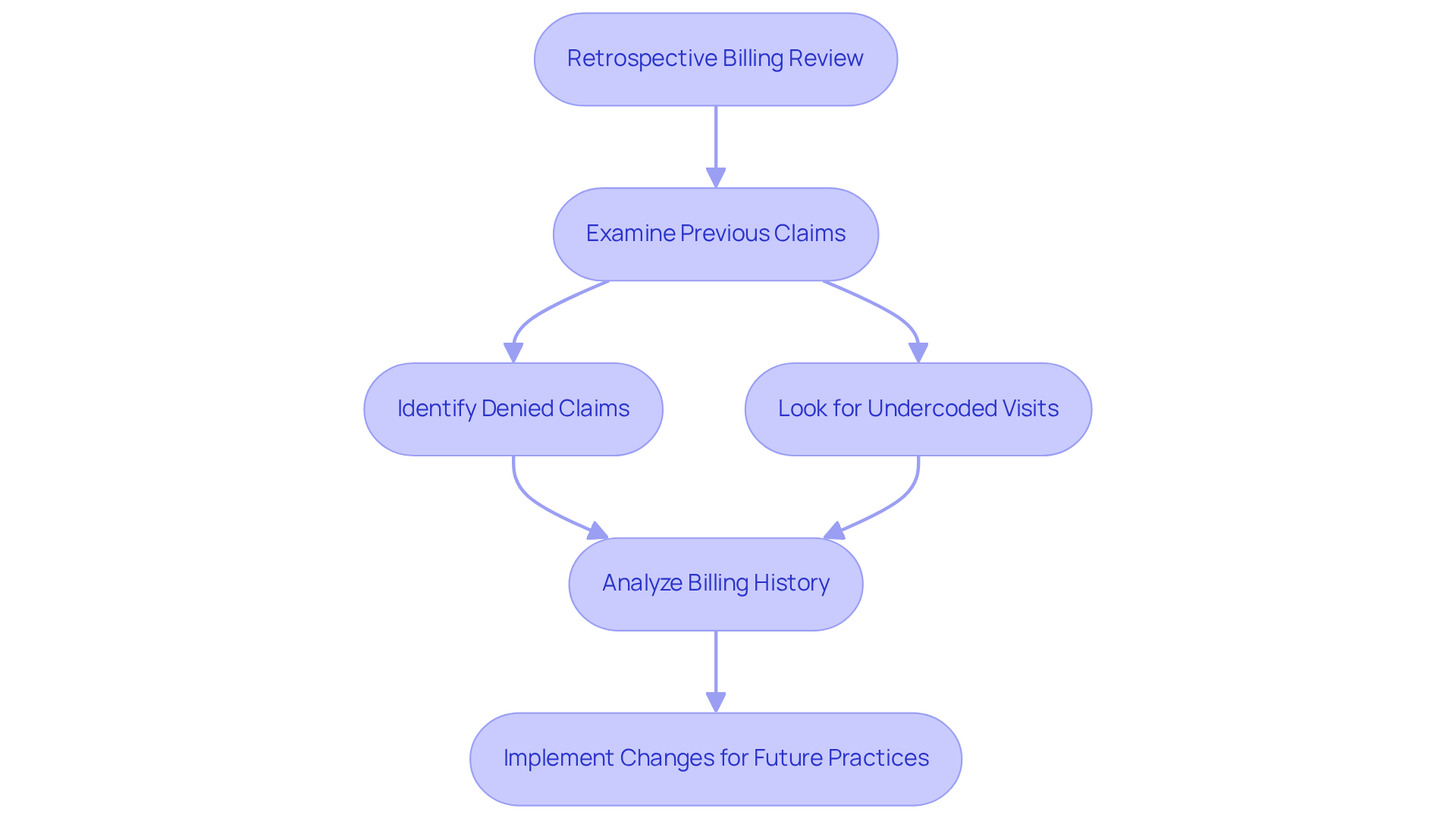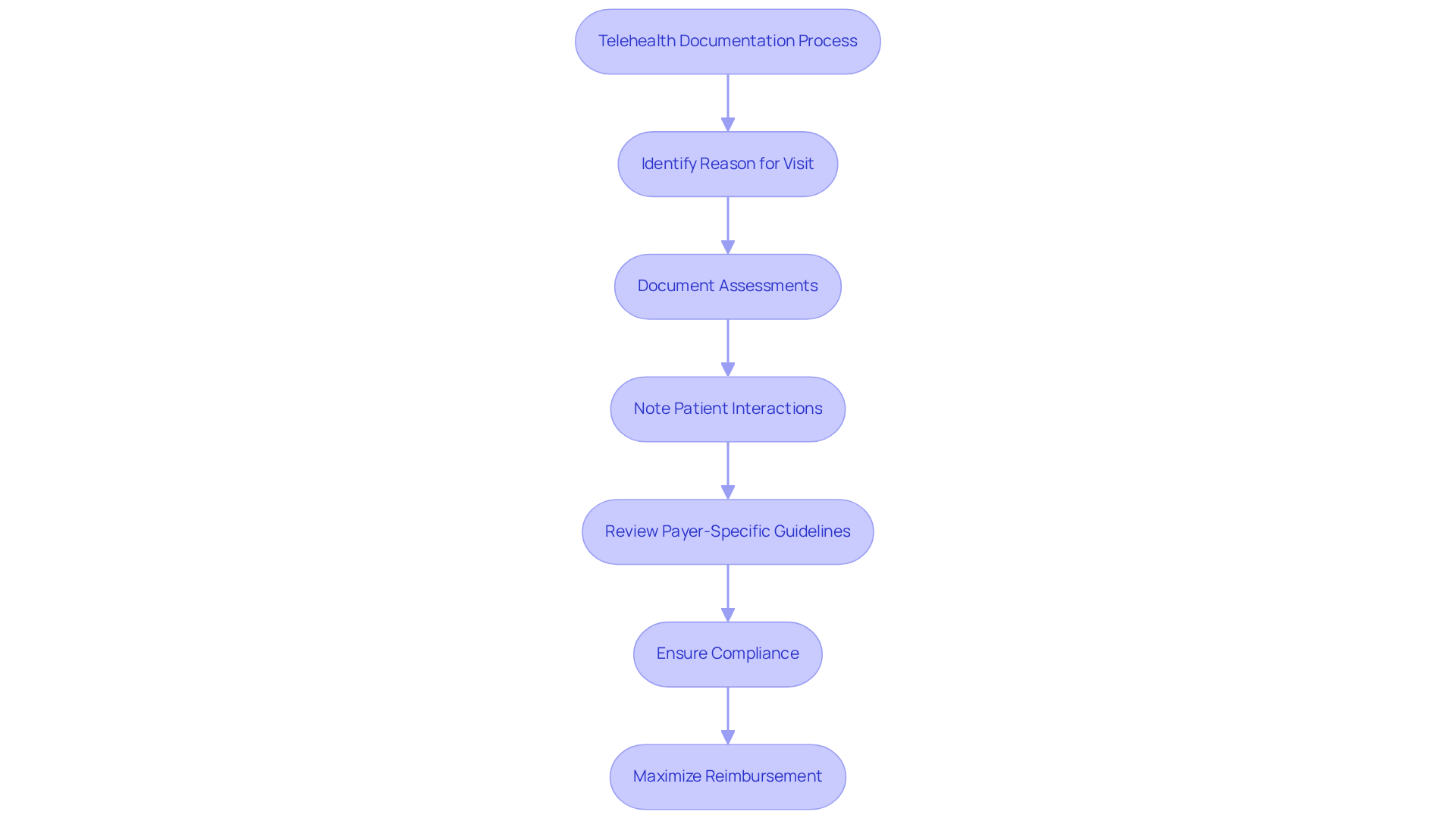Overview
In today's healthcare landscape, providers often grapple with emotional challenges that can feel overwhelming. The main focus of this article is to support you by offering essential strategies for effectively utilizing PMB ICD-10 codes, ultimately aimed at improving both billing and patient care. Accurate coding is not just a technical requirement; it’s a cornerstone of compassionate care that ensures patients receive the attention they deserve.
Continuous staff training is vital, as it empowers your team to navigate the complexities of coding with confidence. By integrating advanced technologies, such as AI, you can streamline billing processes and enhance financial efficiency. This not only lightens administrative burdens but also allows you to concentrate more on what truly matters—your patients.
Imagine a scenario where your team is fully equipped with the knowledge and tools to address billing challenges seamlessly. As you implement these strategies, you’ll find that your ability to provide quality care improves significantly. We encourage you to reflect on these insights and consider how they can transform your practice. Together, we can create a healthcare environment that prioritizes both efficiency and compassionate patient care.
Introduction
Navigating the intricate landscape of PMB ICD-10 coding can be a daunting challenge for healthcare providers. This often leads to emotional stress and administrative burdens that detract from the vital focus on patient care. How can we address these challenges together? This article delves into nine essential strategies designed to empower practitioners. By optimizing billing processes and enhancing coding accuracy, we can work towards improved patient outcomes. As the healthcare industry continues to evolve, it is crucial to consider: how can providers effectively leverage these strategies to not only comply with coding standards but also thrive in an increasingly competitive environment?
CosmaNeura: AI-Driven Billing Optimization for PMB ICD-10 Codes
In today's healthcare landscape, the rising expenses of medical care weigh heavily on both patients and practitioners. CosmaNeura understands these emotional challenges and utilizes advanced AI algorithms to optimize billing procedures specifically for pmb icd 10 codes. By meticulously analyzing patient interactions, the platform not only suggests accurate billing codes but also significantly reduces errors. This not only maximizes revenue potential but also enhances financial efficiency.
Consider the example of Auburn Community Hospital, which achieved a remarkable 50% reduction in discharged-not-final-billed cases and a 40% increase in coder productivity through the use of AI technologies. Such automation alleviates the administrative burden on medical providers, allowing them to devote more time to patient care. This focus on patient care ultimately leads to an improved overall patient experience.
Recent advancements in AI have shown substantial improvements in billing accuracy and efficiency. Medical systems that utilize AI-driven natural language processing (NLP) have reported a notable decrease in claim denials and an increase in coder productivity. Furthermore, AI's capability to detect and rectify claim mistakes prior to submission has proven effective in reducing denials, thereby alleviating the financial pressures faced by medical organizations.
As generative AI continues to advance, specialists foresee considerable uptake in medical services within the next two to five years. This opens the door for more advanced applications that can further enhance financial results for medical practitioners. However, it is essential to implement human validation of AI outputs to mitigate risks associated with generative AI. This ensures a balanced approach to its integration in medical billing, supporting healthcare providers in their mission to deliver exceptional care.

Medical Billing Strategies: Effective Use of PMB ICD-10 Codes
Healthcare providers often face significant emotional challenges as they navigate the complexities of medical classification codes. These burdens can impact their ability to deliver the compassionate care that patients deserve. To alleviate these pressures, it’s essential to adopt a systematic approach to using pmb icd 10 medical classification codes.
Regular training for staff on updates is vital, ensuring everyone is equipped with the latest knowledge. Utilizing software that integrates seamlessly with electronic health records (EHR) can streamline processes, making daily tasks more manageable. Additionally, conducting periodic audits helps maintain compliance and can prevent common mistakes that lead to billing inaccuracies.
Staying informed about changes in classification guidelines is crucial. This not only helps in preventing errors but also guarantees precise billing, which is key to sustaining the financial health of your practice. By embracing these strategies, healthcare providers can focus more on what truly matters—caring for their patients.
Consider how implementing these solutions can ease your administrative burdens and enhance your practice's efficiency. Are you ready to take the next step towards a more streamlined approach? Together, we can ensure that your commitment to patient care shines through every aspect of your work.

Best Practices for ICD-10 Medical Coding in PMB
In the realm of PMB ICD 10 medical classification, healthcare providers frequently encounter emotional challenges due to the complexities of accurate coding and compliance. It’s essential to recognize that maintaining up-to-date programming manuals is not just a task; it’s a lifeline. These manuals provide the latest guidelines and codes necessary for precise documentation, helping to alleviate some of the burdens that providers face. As data specialist Wes McKinney wisely notes, "Get the definitive handbook for manipulating, processing, cleaning, and crunching datasets in Python." This highlights the importance of having the right resources at hand. Regular updates to programming manuals are crucial for preventing mistakes and ensuring compliance with current standards.
Employing advanced programming software that offers real-time suggestions can significantly enhance accuracy in programming. These tools simplify the programming process and assist in identifying the most suitable codes based on the clinical documentation provided. Practices that integrate such software often report a remarkable improvement in programming efficiency and a reduction in claim denials. Isn’t it comforting to know that technology can support us in our daily tasks?
Another cornerstone of effective categorization lies in thorough and precise clinical documentation. Medical professionals must ensure that all patient interactions are carefully documented, as this record directly influences the precision of the PMB ICD 10 classification. Regular training sessions for development personnel can further enhance their understanding of the latest programming changes and best practices, fostering a culture of continuous improvement within the practice. How often do we take a moment to reflect on the impact of our documentation?
Recent trends indicate an increasing reliance on programming software among medical professionals, signaling a move toward more automated and efficient programming processes. As the healthcare landscape evolves, staying informed about these trends and applying best practices will be vital in enhancing classification in PMB ICD 10. Let’s embrace these changes together, ensuring we provide the best care possible for our patients.

Common PMB Conditions: Essential ICD-10 Codes to Know
Healthcare providers often face significant emotional challenges, especially when navigating the complexities of diagnostic coding for prevalent PMB conditions such as hypertension (I10), diabetes mellitus (E11), and chronic obstructive pulmonary disease (J44). Mastery of these essential codes is not just about compliance; it directly influences the financial health of a practice and streamlines the billing process, alleviating some of the administrative burdens that can detract from patient care.
Research indicates that precise coding can lead to enhanced reimbursement rates, with 89 percent of medical practices expressing concerns about clinical documentation changes following the implementation of new coding standards. This highlights the emotional weight of these changes on healthcare providers, who are already stretched thin. Understanding coding systems is vital for optimizing revenue and ensuring that healthcare professionals can continue to focus on what truly matters—their patients.
As one physician wisely noted, "Understanding these codes is not just about compliance; it directly influences the financial health of a practice." Practitioners who leverage their knowledge of diagnostic codes report improved billing procedures, resulting in fewer claim denials and a more efficient revenue cycle. This not only eases their workload but also enhances the care they provide.
Looking ahead to 2025, the ongoing evolution of medical billing practices underscores the necessity for healthcare providers to remain informed about coding standards. By doing so, they can effectively manage the intricacies of reimbursement, ensuring they are prepared to navigate future challenges with confidence. Staying educated about these essential coding systems is a proactive step towards fostering a healthier practice environment and ultimately better patient care.

Challenges in PMB Implementation: Navigating ICD-10 Coding Issues
In the journey of implementing PMB, healthcare providers often encounter emotional challenges, such as staff resistance to change and the stress of navigating complex guidelines. These obstacles can weigh heavily on the ability to deliver quality patient care. Have you felt the strain of insufficient training on PMB ICD 10 classification? You're not alone.
To foster a supportive environment, it's essential to invest in comprehensive training programs that not only educate but also encourage a culture of adaptability. Imagine a workplace where change is embraced, leading to improved collaboration and morale.
Moreover, innovative AI solutions, like CosmaNeura's Agentic Platform, can significantly ease the programming process and reduce administrative burdens. By harnessing intuitive programming software and generative AI, healthcare providers can enhance patient care while effectively managing the complexities of medical classification.
Consider the benefits:
- Streamlined processes
- Reduced stress
- More time to focus on what truly matters—your patients
Let's take action together by exploring these solutions and creating a more compassionate healthcare environment.
ICD-10 Integration: Enhancing PMB Billing and Claims Compliance
Incorporating diagnostic classification into PMB ICD 10 billing procedures is essential for easing the emotional burden on healthcare providers and improving claims compliance. Have you ever felt overwhelmed by the complexities of billing? EHR systems that facilitate PMB ICD 10 integration play a vital role in this process by automatically updating classifications according to the latest guidelines. This seamless integration not only streamlines the billing process but also significantly reduces the risk of errors that can lead to claim denials.
In fact, studies indicate that effective integration can enhance claims compliance rates by up to 30%. This improvement allows practitioners to focus more on patient care rather than getting bogged down by administrative tasks. Imagine having the time to truly connect with your patients, rather than stressing over paperwork. Furthermore, EHR specialists emphasize that timely updates and accurate coding, particularly with PMB ICD 10, are crucial for maintaining compliance and optimizing reimbursement.
By utilizing advanced EHR features, medical professionals can ensure their billing practices align with coding requirements. This not only improves operational efficiency but also enhances financial performance. Embrace the tools available to you—your dedication to patient care deserves the support of a streamlined administrative process. Let's work together to navigate these challenges and prioritize what truly matters: the well-being of your patients.

Retrospective Billing Analysis: Recovering Revenue with PMB ICD-10 Codes
Performing a retrospective billing review can feel overwhelming, especially when healthcare providers are already stretched thin. It's essential to examine previous claims to uncover missed opportunities for billing using pmb icd 10 codes. By taking the time to analyze billing history, particularly focusing on denied claims and undercoded visits, providers can find valuable insights.
Identifying patterns and areas for improvement not only alleviates some of the administrative burdens but also enhances revenue recovery. Imagine the difference it could make in your practice if you could optimize future billing practices.
By implementing thoughtful changes, medical professionals can foster a more efficient billing process, ultimately allowing them to focus more on patient care. Have you considered how these adjustments could positively impact your practice?
Take a moment to reflect on your billing approach. With a proactive mindset, you can create a more sustainable and supportive environment for both your team and your patients. Together, let’s strive for excellence in every aspect of care.

Telehealth Coding: Utilizing PMB ICD-10 Codes for Remote Visits
Precise documentation for telehealth appointments is not just a requirement; it is essential for healthcare professionals who are navigating the complexities of remote consultations. Have you ever felt overwhelmed by the administrative burdens that can detract from patient care? Effective documentation encompasses the reason for the visit, assessments made during the session, and any relevant patient interactions. Staying informed about payer-specific guidelines is crucial, as these can vary significantly and directly affect reimbursement outcomes.
As telehealth continues to evolve, the importance of precise documentation cannot be overstated. It ensures compliance and maximizes the potential for reimbursement, which is vital in today’s healthcare landscape. Experts emphasize that thorough documentation is key to justifying the time spent with each patient, especially as payers increasingly scrutinize these details. In 2025, the introduction of new telemedicine codes will further require compliance with revised billing practices, making it essential for practitioners to remain vigilant in their documentation efforts.
By prioritizing accurate documentation, you not only enhance your practice but also contribute to better patient outcomes. Consider the impact of your documentation on the overall care experience. Let’s work together to navigate these challenges and ensure that your efforts are recognized and rewarded.

FAQs on PMB ICD-10 Codes: Essential Information for Healthcare Providers
Healthcare providers often experience emotional challenges when navigating the complexities of pmb icd 10 coding. Questions about selecting the right codes, understanding the importance of documentation, and managing updates regarding pmb icd 10 can feel overwhelming. It's essential to recognize how these administrative burdens can impact patient care.
By seeking clarification on uncertainties, healthcare providers can alleviate some of this stress. Utilizing resources like coding manuals and professional organizations can empower them to stay informed about best practices and coding changes. This not only enhances their confidence but also improves the quality of care they provide.
If you find yourself facing these challenges, remember that you are not alone. Many others share your concerns, and there are solutions available. Embracing these resources can lead to a more streamlined process, ultimately benefiting both providers and patients. Don't hesitate to reach out and engage with your peers and resources to navigate these complexities together.
Conclusion
Navigating the complexities of medical billing can be overwhelming for healthcare providers, often impacting the quality of patient care. The integration of PMB ICD-10 strategies offers a pathway to alleviate these administrative burdens, allowing practitioners to focus on what truly matters: delivering compassionate care to their patients.
Continuous training, the use of AI-driven solutions, and precise documentation are vital in enhancing billing practices. Successful case studies, such as Auburn Community Hospital, illustrate the tangible benefits of these strategies, showing significant reductions in errors and improvements in coder productivity. Staying informed about coding updates and utilizing effective tools not only fosters better compliance but also supports the financial health of healthcare practices.
As the healthcare landscape continues to evolve, the need to embrace these PMB ICD-10 strategies becomes increasingly important. By taking proactive steps to implement best practices and leveraging available resources, healthcare providers can create a more efficient and supportive environment. This commitment enhances operational efficiency and significantly contributes to better patient outcomes.
The time to act is now. Together, let’s ensure that our focus remains on what truly matters: the well-being of our patients. How can we work together to foster a more compassionate and effective healthcare system?




